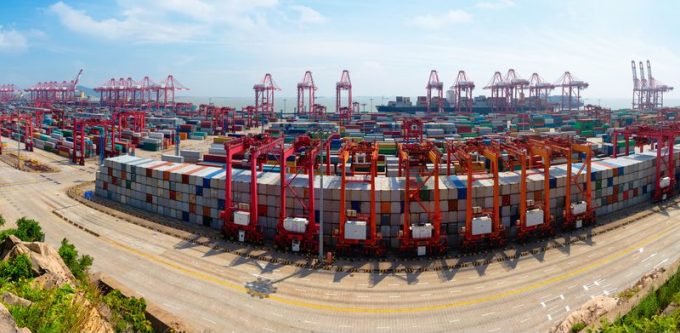Container spot rates have peaked as all major trades see prices fall
There was more evidence in this week’s container port freight markets that peak prices on ...
TFII: SOLID AS USUALMAERSK: WEAKENINGF: FALLING OFF A CLIFFAAPL: 'BOTTLENECK IN MAINLAND CHINA'AAPL: CHINA TRENDSDHL: GROWTH CAPEXR: ANOTHER SOLID DELIVERYMFT: HERE COMES THE FALLDSV: LOOK AT SCHENKER PERFORMANCEUPS: A WAVE OF DOWNGRADES DSV: BARGAIN BINKNX: EARNINGS OUTODFL: RISING AND FALLING AND THEN RISING
TFII: SOLID AS USUALMAERSK: WEAKENINGF: FALLING OFF A CLIFFAAPL: 'BOTTLENECK IN MAINLAND CHINA'AAPL: CHINA TRENDSDHL: GROWTH CAPEXR: ANOTHER SOLID DELIVERYMFT: HERE COMES THE FALLDSV: LOOK AT SCHENKER PERFORMANCEUPS: A WAVE OF DOWNGRADES DSV: BARGAIN BINKNX: EARNINGS OUTODFL: RISING AND FALLING AND THEN RISING

Today’s Shanghai Containerized Freight Index (SCFI) shows no sign of a recovery with spot rates for most trades still dropping, following a break for China’s Golden Week holiday.
The Asia-North Europe component of the SCFI recorded a further 2% decline, to $581 per teu, which is 21% below the level of the same week of last year.
After a miserable peak season, which caused carriers to start their winter blanking programmes earlier than usual, container lines were again disappointed by the absence of an expected cargo rush prior to the holiday factory shutdowns.
According to the SCFI commentary, the average slot utilisation levels for loaders to north Europe fell to around 85% in the week prior to the holiday. It said: “Most carriers cut prices to secure their customers as market competition intensified.”
And with the slack season now upon them, carriers need to take further action to halt the rate erosion before the spot market deteriorates to crisis levels.
Indeed, The Loadstar has heard this week of carriers on the route touting volume rates below $500 per teu and agreeing to waive implementation of their IMO 2020 low-sulphur surcharges until December.
It is also understood that carriers have been forced to row back on their contracts with some major forwarders and offer loyalty discounts as the spread between contract and spot has widened.
Meanwhile, carriers serving the Asia-Mediterranean trade also saw rates fall, with the SCFI recording a 2.7% drop to $722 per teu.
However, the route is in a significantly healthier position than north Europe, evidenced by 90%-plus load factors on sailings and a spot rate just 4% shy of a year ago.
Nevertheless, with the parlous state of the north Europe tradelane, carriers will need to be careful not to deploy too much of their idled tonnage to the Mediterranean services and thus risk a similar collapse.
On the transpacific trades, carriers are also struggling to contain spot rate erosion and this week announced a number of blanked voyages from Asia to the US east coast.
The 2M alliance and Zim have cancelled five sailings this month, with Maersk saying it had decided to adjust capacity due to a “slow volume pickup following the Chinese national holiday”. It also warned it might need to make “further adjustments” to advertised services.
On Wednesday, rival THE Alliance’s lead line, Hapag-Lloyd, said it was to “seasonally suspend” its ECS (East Coast 3) loop 3 service after the sailing of the 8,200 teu YM Utopia from Asia on 31 October.
Spot rates from Asia to the US are continuing to drop: the SCFI reading for the east coast fell again this week, but only slightly, edging down by 0.5% to $2,335 per 40ft, perhaps boosted by the blankings and suspended service announcements, but the rate is still 29% below the level of a year ago.
But matters are more serious on the west coast, where the SCFI component fell to $1,313 per 40ft after another 1.1% decline, and is now a massive 48% lower than 12 months ago, when transpacific rates were buoyed by significant front-loading to beat the impact of the first tranche of US duties on a range of Chinese imports.
Notwithstanding the outcome of the US-China trade talks this week, next week will see the current 25% tariffs on $250bn worth of imports increased to 30%, a forerunner to new tariffs, on virtually all other Chinese imported consumer goods, stemmed for 15 December.
However, if a trade deal is not struck, it could prove to be a short-term silver lining for beleaguered carriers, possibly prompting a new surge of tariff-beating front-loading, particularly for the shorter-transit US west coast services.
“Retailers are doing all they can to mitigate the impact of tariffs on their customers,” said Jonathan Gold the US National Retail Federation’s vice president for supply chain and customs policy, this week.
Comment on this article